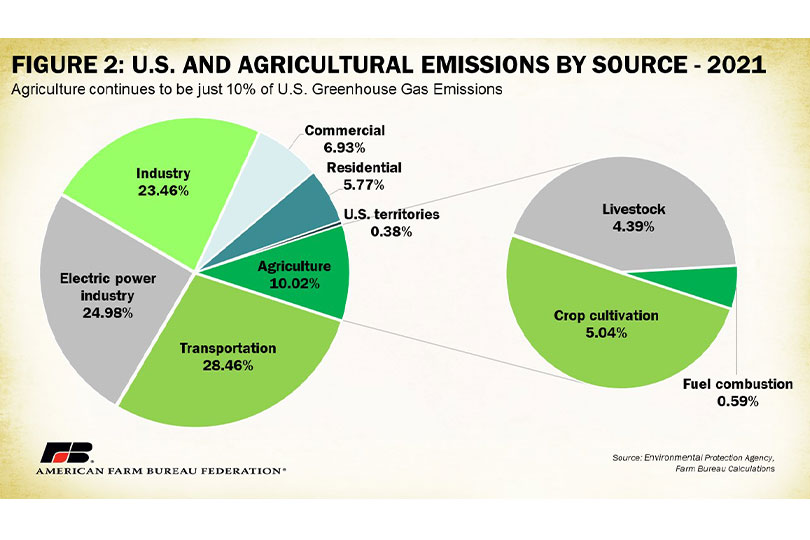By Emmy Powell
Communications Specialist
A recent report from the U.S. Environmental Protection Agency (EPA) highlights agriculture’s continuing advancements in sustainability and reduction in greenhouse gas emissions.
“U.S. agriculture is producing more food, fiber and renewable fuel for more people while using fewer resources and emitting fewer greenhouse gases,” American Farm Bureau Federation (AFBF) Economist Daniel Munch said.
The report, Inventory of U.S. Greenhouse Gas Emissions and Sinks, shows that U.S. agriculture represents just 10% of total U.S. emissions when compared to other economic sectors. Agricultural emissions dropped 0.2% from 2020 to 2021, while overall U.S. greenhouse gas emissions increased by 5.2% during that timeframe.
AFBF economists noted the report shows the return of economic activity once COVID-19 lockdowns were lifted, and that’s likely the cause of the increase of greenhouse gases over the years. But agricultural production continued during the pandemic shutdown.
“Agricultural production remained vital throughout the COVID-19 disruptions and lockdowns as the world still required food,” Munch said.
The report showed the largest emissions source was the transportation sector, representing 28% of total emissions.
Following transportation, electricity generation represented 25% of the total.
The decrease in agricultural emissions highlighted in the report continues a pattern of sustainability success over several years for U.S. farmers and ranchers.
Agricultural emissions dropped 2.7% between 2019 and 2020 and declined 2.2% between 2018 and 2019.
“Productivity is increasing, as it must to help feed a growing global population, while emissions are on the decline relative to this productivity and population increase,” Munch said.
Innovation and advancements in technology allow for that improved production.
The adoption of conservation practices through voluntary, market-based incentives also have helped farmers and ranchers trap 754 million metric tons of carbon in the soil.
“The latest report shows that when agriculture is recognized as a partner in reducing greenhouse gas emissions, farmers and ranchers have more opportunities to utilize voluntary, market-based incentives that work to reduce agriculture’s environmental footprint while helping farmers and ranchers economically produce the food, fiber and renewable fuel U.S. families, and the world, rely on,” AFBF economists said.
The economists also note it is important that the United States continues to invest in agricultural research to allow farmers and ranchers to be part of cutting-edge plant and animal technologies that increase productivity, capture more carbon in the soil and greenhouse gases even more, among many other environmental benefits.


